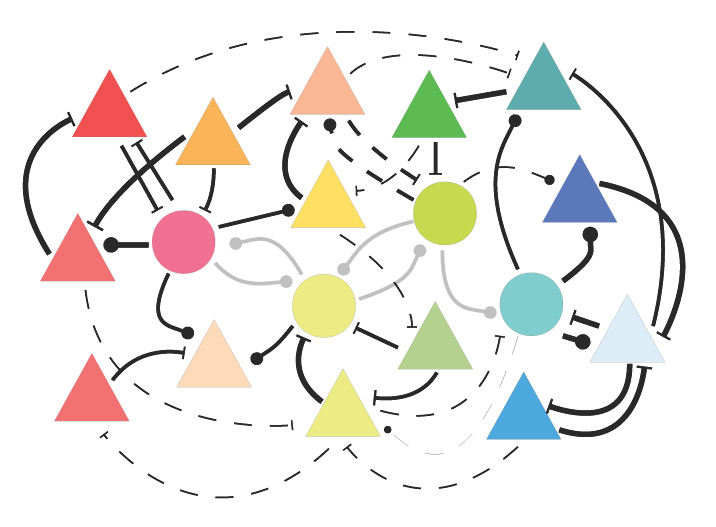Fine Tuning in the Brain

The connections between nerve cells that react to similar stimuli are strengthened as they gain visual experience (thick lines), while other connections are weakened (thin lines). Copyright: Stefan Rotter / Bernstein Center Freiburg, 2015
When newborn babies open their eyes for the first time, they already possess nerve cells specialized in particular stimuli in the visual cortex of their brains – but these nerve cells are not systematically linked with each other. How do neural networks that react in a particular way to particular features of a stimulus develop over the course of time?
In order to better understand the steps of this development and explain the complicated processes of reorganization they involve, an international team of researchers has now developed a computer model that precisely simulates the biological processes.
The results of the study by Prof. Dr. Stefan Rotter, Bernstein Center Freiburg (BCF) and Cluster of Excellence BrainLinks-BrainTools of the University of Freiburg, conducted in cooperation with Dr. Claudia Clopath from the Imperial College London, England, have now been published in the journals PLOS Computational Biology and PLOS ONE.
“Our model enabled us to achieve a meaningful combination of typical features of biological neural networks in animals and humans in a computer simulation for the first time ever,” reports the neuroscientist Dr. Sadra Sadeh from the BCF. “The networks harness the principle of feedback to make nerve cells in the visual system into efficient detectors of features.
In addition, they can precisely coordinate the points of contact between the cells – the synapses – in learning processes.” It is difficult to combine these two properties in computer models, because it can easily lead to an explosion of activity in the network – similar to an epileptic fit. To keep the activity in the network stable, the researchers integrated inhibitory synapses into the learning process, which control the excitation in the network.
Researchers can now use the computer model to simulate various developmental processes in the brain’s visual cortex. Among other things, it will allow them to determine how connections between the nerve cells change the first time they receive stimuli from both eyes after birth. Such processes play a role in early-childhood visual disorders like congenital strabismus (squinting). “In the long term, the model could even enable us to develop better strategies for treating such illnesses,” says Rotter.
But why do the neural networks change their structures in the course of visual experience if nerve cells are already specialized in particular stimuli at the moment the eyes first open? The team found an answer to this question in a parallel study.
“In a simulation directly comparing inexperienced and fully developed nerve cell networks, we were able to demonstrate that fully developed networks further strengthen components of a stimulus that carry more information by preferring connections of neurons with the same function,” explains Rotter. Therefore, while newborns do indeed have the capacity to process all stimuli when they first open their eyes, their perception is greatly improved through the fine tuning of the nerve cell connections.
The Bernstein Center Freiburg is part of the National Bernstein Network Computational Neuroscience in Germany. With this funding initiative, the German Federal Ministry of Education and Research (BMBF) has supported the new discipline of Computational Neuroscience since 2004 with over 180 million Euros. The network is named after the German physiologist Julius Bernstein (1835-1917).
Contact:
Prof. Dr. Stefan Rotter
University of Freiburg
Bernstein Center Freiburg
Hansastraße 9A
7904 Freiburg (Germany)
Tel: +49 (0)761-203 9316
Email: stefan.rotter@biologie.uni-freiburg.de
Original publications:
S. Sadeh, C. Clopath & S. Rotter (2015): Emergence of functional specificity in balanced networks with synaptic plasticity. PLOS Computational Biology 11(6): e1004307
doi:10.1371/journal.pcbi.1004307
S. Sadeh, C. Clopath & S. Rotter (2015): Processing of feature selectivity in cortical networks with specific connectivity. PLOS ONE 10(6): e0127547
doi:10.1371/journal.pone.0127547
https://www.bcf.uni-freiburg.de/people/details/rotter Website Stefan Rotter
https://www.bcf.uni-freiburg.de Bernstein Center Freiburg
http://www.uni-freiburg.de University of Freiburg
http://www.nncn.de National Bernstein Network Computational Neuroscience
Media Contact
All latest news from the category: Life Sciences and Chemistry
Articles and reports from the Life Sciences and chemistry area deal with applied and basic research into modern biology, chemistry and human medicine.
Valuable information can be found on a range of life sciences fields including bacteriology, biochemistry, bionics, bioinformatics, biophysics, biotechnology, genetics, geobotany, human biology, marine biology, microbiology, molecular biology, cellular biology, zoology, bioinorganic chemistry, microchemistry and environmental chemistry.
Newest articles

A ‘language’ for ML models to predict nanopore properties
A large number of 2D materials like graphene can have nanopores – small holes formed by missing atoms through which foreign substances can pass. The properties of these nanopores dictate many…

Clinically validated, wearable ultrasound patch
… for continuous blood pressure monitoring. A team of researchers at the University of California San Diego has developed a new and improved wearable ultrasound patch for continuous and noninvasive…

A new puzzle piece for string theory research
Dr. Ksenia Fedosova from the Cluster of Excellence Mathematics Münster, along with an international research team, has proven a conjecture in string theory that physicists had proposed regarding certain equations….



